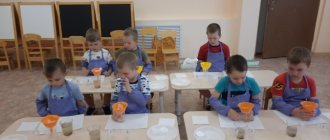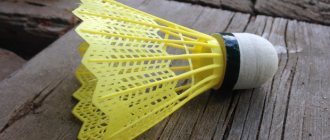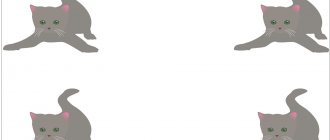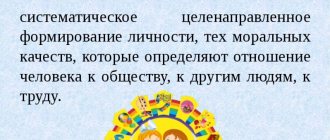Multicultural education of children in kindergarten
Multicultural education of preschool children
Description. The article traces the relevance of multicultural education in a modern state. Goals and objectives of multicultural education of preschool children. Forms, methods and means of implementing these tasks in a preschool organization. The material will be of interest to preschool teachers. We live in a multinational state. Historically, Russia is the homeland of different peoples who speak different languages, profess different religions, and have distinct cultures and mentalities. We have a common history and a common future. For centuries, mutual understanding and mutual assistance between people of different cultures have been the basis of the historical development of the nation. And we must constantly learn and teach our children to accept each other as they are - regardless of nationality, religion, beliefs and customs. Learn to respect each other and protect interethnic harmony in our country. The Law of the Russian Federation “On Education” (Article 14) states that “the content of education must ensure ... the integration of the individual into national and world culture.” Consequently, every member of modern society is faced with the need to be ready for interethnic communication with objects of a different national culture, and today, more than ever, it has become important to be able to live in a multinational society. Along with this, the Federal State Educational Standard for Preschool Education spells out the basic principles: introducing children to sociocultural norms, traditions of the family, society and state, taking into account the ethnocultural situation of the child’s development. The multiculturalism of any territory of our country determines the need for multicultural education. Multicultural education is raising a child in the culture of the peoples of the region where the child lives, with a priority for him the culture of his nationality, the formation of tolerance. The ability to live in a world of different people and ideas, the ability to have rights and freedoms, without violating the rights and freedoms of other people, i.e. tolerance is not inherited. In each generation they must be educated again and again. Education, starting from preschool, should help ensure that, on the one hand, the child understands his roots and thereby can determine the place he occupies in the world, and on the other, instill in him respect for other cultures. Everyone has the right to develop spiritually on the basis of the cultural heritage of their people, observing folk traditions, customs, rituals, introducing the younger generation to all this, relying on centuries-old folk pedagogy. For a modern person, knowing only about one’s own people is very little. I also want to be able to do what other peoples can do: dance, play their games, try to cook their national dishes, sing and speak like them. To make it easier to communicate, learn languages, know at least 3-4. This desire helps to expand the child’s horizons, the formation of a worldview, and tolerance. Children develop cognitive abilities, intelligence, thinking, a sense of patriotism, pride in their people, and not only in their own. This means that the child should receive not only national, but also multicultural education. Immersion in the culture of their region, their locality allows the child to feel and understand not only the characteristics of national cultures, but also the mechanisms of their interaction. For a long time, the national components of regional culture not only coexisted, but also interpenetrated, complemented, and mutually enriched each other, while maintaining their own unique uniqueness. By comprehending regional culture, a preschooler learns ethnic norms and rules that prescribe sympathy, friendliness and respect for peers and adults of different nationalities, interest in their lives and their culture. The idea of multiculturalism on a regional basis is self-respect and respect for others. Knowledge of the national traditions of the peoples living in a given territory through their analysis and comparison. Taking into account the social experience, interests and psychophysiological characteristics of the development of preschool children, a preschool child can be called a “multicultural personality of a preschooler” if he has basic ideas about his native land, its nature, material and spiritual culture, art, literature, traditions of his people and the peoples of the immediate and distant national surroundings; knows the norms of behavior in everyday life and society, knows how to comply with them; knows how to reproduce acquired knowledge and ideas in his life. In other words, the goal of multicultural education in preschool pedagogy can be considered the formation of just such a multicultural personality. This determines the specific tasks of multicultural education of preschoolers: developing children's ideas about the diversity of cultures in the world and Russia, cultivating a positive attitude towards cultural differences; development of skills and abilities of productive interaction with speakers of different cultures; raising children in the spirit of peace, tolerance, humane interethnic communication. To implement these tasks, the content of multicultural education must meet the following requirements: - reflection of humanistic ideas in the material; — characteristics of original unique features in the culture of the peoples of Russia and other countries; — disclosure in the culture of Russian peoples of common elements of traditions that allow them to live in peace and harmony; - introducing children to their native culture, and from it to Russian and world culture. Multicultural education of children is carried out in three directions: - information saturation (communication of knowledge about the traditions, customs of different peoples, the specifics of their culture and values, etc.); - emotional impact (in the process of implementing the first direction of “information saturation”, it is important to evoke a response in the child’s soul, to “stir up” his feelings); - behavioral norms (the knowledge acquired by a child about the norms of relationships between peoples, the rules of etiquette, must be reinforced in his own behavior). To implement these three directions, various means are used: - oral folk art; - fiction; — musical folk art; — decorative and applied arts, painting; — folk holidays, rituals, traditions; — ethnic mini-museums. There are many representatives of the peoples of the Volga region living in our republic. And our region can be considered purely Tatar. Aktanysh district of the Republic of Tatarstan is located in the northeast of the republic, bordering Bashkortostan and Udmurtia. The district consists of 26 rural settlements, including 87 settlements. Today the population of the district is 32 thousand people. Of these, Tatars – 98.07%, Mari – 1.83%, Russians – 0.09%. Our “Kindergarten of a combined type No. 6” is located in the center of the Aktanysh region - in the village of Aktanysh, where mainly Tatars live, but there are also international families. Children, starting from the middle group, learn Russian. Language teaching is carried out according to the educational and methodological set “Learning the Russian Language” (S.M. Gaffarova), which includes teaching aids, workbooks, demonstration and handouts, audio recordings and cartoons. And at the same time, along with Tatar folk culture, preschoolers begin to get acquainted with the culture of the Russian people and other peoples of the Volga region. The main directions through which multicultural education of children is implemented in our preschool educational institution are: - educational activities carried out in the process of organizing various types of activities; — educational activities carried out during regime moments; - independent activity of children; - interaction with children's families. Multicultural education of preschool children is integrated in various types of activities and is implemented in educational areas: - social and communicative development; — cognitive development; - speech development; — artistic and aesthetic development; - physical development. To solve the problems of multicultural education, corners for familiarization with the native land have been created in groups: “Native Land - Tatarstan”. There are dolls in national costumes, models of national dishes, albums about the diversity of folk art and crafts; materials for educational conversations about the native land, about the Motherland - Russia, about Moscow - the capital of Russia; state symbols of Tatarstan, Russia; basic information about the history, traditions and customs of the peoples of the Volga region. The competitions held as part of the August conference of educators: “Doll in Russian national costume”, “Doll in Tatar national costume” help to see the diversity and beauty of the national costume. The competition materials add to the collection of the local history corner. A series of thematic lessons on teaching the Russian language has been developed: “Let's decorate grandma's apron”, “We live together in Tatarstan”, “Russia”, “Peoples of the Volga region”, which includes the integration of various types of activities. During music classes, children get acquainted with ritual songs and dances of different nations. In the process of direct educational activity, through the perception of works of artistic culture, preschoolers discover the world of human values, reflected in art through the artistic and expressive means of music, painting, literature and methods of communication. Children are introduced to the cultural wealth of the Russian people through oral folk art: proverbs, sayings, fairy tales, legends. An important point in children’s mastery of a multicultural space is familiarization with fiction. Getting to know the literary riches of their native land allows them to instill in children a love for their “small” homeland, respect for their history, peoples, and language; form primary value orientations. By organizing the “Reciters' Competition,” during which children expressively read poetry in the Tatar and Russian languages, we instill love for their native language and respect for the Russian language. Play is the leading activity of a preschooler. Children love folk games: moving, verbal, round dancing. In the process of didactic games, we have the opportunity to lay the foundations of multicultural education in children, for example, “Name the elements of the national costume”, “The fourth odd one”, “Which fairy tale is the hero from?”, “Name the dish”, “Dress the doll in the national costume”. In the ethnic mini-museum of decorative and applied arts created in the garden, children get acquainted with folk toys, with examples of Gzhel, Khokhloma, Gorodets, and Filimonov paintings. They learn to see the beauty of folk toys. With the help of such didactic games as “Make a pattern”, “Find a fragment”, lotto “Which painting?” develop the ability to distinguish paintings. With the children of the school preparatory group, I organized a Russian language club “Gatherings”. There we learn nursery rhymes, proverbs and sayings, riddles, songs and round dances of the Russian people; we dramatize fairy tales; We play folk games. An integral part of folk culture are folk holidays, customs, and traditions. Traditionally, Tatar folk festivals are held in kindergarten: “Sabantuy”, “Syumbela”, “Nauruz”, “Kaz omese”. As a result of group work, together with children and parents, we hold “Gatherings”, “Evenings of riddles and answers”, and celebrate “Maslenitsa. One of the important links in multicultural education of preschool children is the interaction between teachers and parents of children. We involve parents in the educational process through preparing children for ethnic holidays, reading competitions, thematic exhibitions, making homemade books, albums, and crafts. We actively involve parents in organizing photo exhibitions, making costumes for dolls that reflect regional cultural characteristics, jointly producing homemade books, and creating a local history corner. Thus, the holistic system allows us, in the conditions of a preschool institution, to form in preschool children an idea of regional characteristics and other cultural differences, as well as to introduce people of another culture, other traditions living in a given area to the perception, while simultaneously finding in them universal human values (kindness , friendship, honesty, love, justice, mutual assistance). Forming a culture of interethnic relations is a complex and lengthy process. The ability for intercultural interaction cannot be “worked out” during a cycle of classes, within a series of events, because the very fact of our existence in society will constantly give us food for thought, comprehension, rethinking and expanding the existing cultural baggage, renewal behavioral patterns and habitual picture of the world. Therefore, we need to continue working in this direction.
We recommend watching:
Sex education for older preschoolers Patriotic education of preschoolers in preschool educational institutions Education of preschool children through familiarization with the nature of Yamal Spiritual and moral education of preschoolers
Similar articles:
Interaction between teacher and parents in kindergarten
Sensory education of preschool children
Literature
- Babaeva T.I. Childhood. Sample basic general education program for preschool education. - St. Petersburg, 2011. - pp. 498-508.
- Babaeva T.I. Monitoring in kindergarten: scientific method. allowance. - St. Petersburg, 2011. - pp. 172-189.
- Evdokimova E. S. Design technology in preschool educational institutions. - M., 2006.
- Losev P. N. Management of methodological work in a modern preschool educational institution. - M., 2005.
- Shmonina L.V. Innovative technologies in the methodological work of preschool educational institutions: planning, forms of work. - Volgograd, 2011.
Material provided by the magazine PRESCHOOL PEDAGOGY, No. 1, 2014.





